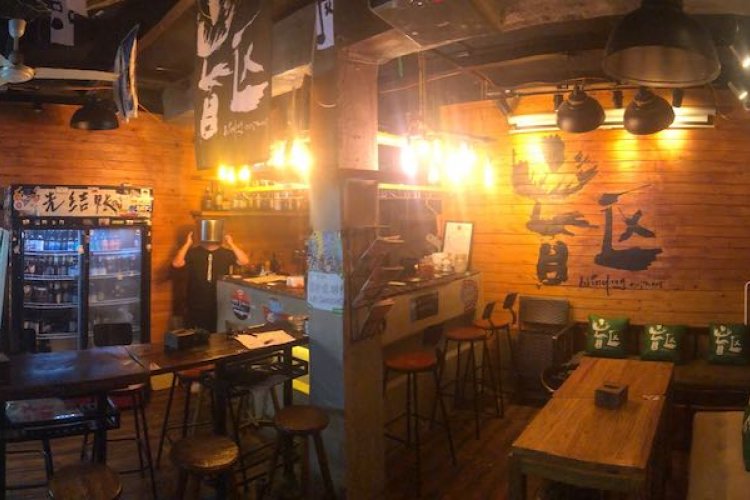Inside the Egg
Designed by French architect Paul Andreu, China’s National Grand Theater is located just to the west of Tian'anmen Square. The building, which couldn’t be more different from the Stalinist seriousness of the neighboring Great Hall of the People, cost RMB 2.69 billion to construct and consists of three large halls – a 2,416-seat opera house, a 2,017-seat concert hall and a 1,040-seat theater. Criticisms of the egg-shaped building (you can find examples here and here) were given an extra boost in 2004 when the Andreu-designed extension of Paris’ Charles de Gaulle airport collapsed and killed two Chinese citizens.
Both domestic and foreign media have been trumpeting last night’s "opening" performance of the revolutionary ballet The Red Detachment of Women in front of an audience limited to builders who constructed the theater, migrant workers, journalists and local residents who were relocated to make way for the titanium-plated structure, as the venues' premiere performance. However, despite all the big proclamations, the venue has been holding unofficial test performances for over a week. Although she missed Jiang Zemin belting out of a few arias last Friday, our new Stage, Cinema and Books editor Alice Liu did manage to sneak into a performance of another revolutionary production, Sister Jiang, last Wednesday. She offers this report from inside the egg:
Last Wednesday, Simon, our photographer, and I stepped into the National Theater (more lovingly known to laobaixing as "the egg")and it was obvious we were witnessing something very special. “Historical event,” “beautiful” and “impressive” were words we kept repeating to each other during our three-hour stay. Spacious and classy, everything seemed translucent inside the Theater. The columns shone and reflected light. The ceiling was glassy and transparent, and we could see the waves from the water feature on the other side of the ceiling through the glass. The circular structure of the theater made the main hall seem even more elongated.
The National Theater is not open to the public – yet. We walked into its opera hall – semi-circular, grand and dazzling. It was already packed with an eclectic mix of people; soldiers, officials, people related to the performing troupe (which belonged to the Chinese Air force), and other unknown groups. The trial opera running that day was Sister Jiang (Jiang Jie) – a heavy dose of communist history and propaganda, but based on the true story of communist Jiang Zhuyun. Set during the civil war between the nationalists and the communists, Jiang Jie is the selfless heroine who is happy to fenshen suigu (basically, die) for the Chinese revolution.
Although Sister Jiang is a typical geming opera - with workers and peasants as main characters, and Jiang Jie a revolutionary who coldly laughs and spits in the face of the nationalists, Sister Jiang at the National Theater was different to any film or stage version I’ve ever seen.
The show is magnificent. The acoustics are, regretfully, passable but very loud during climatic moments. One of the most impressive features - if not the most astounding on stage - is the screen in front of the stage itself. The screen acts like a cinema screen, coming down in front of the stage before every scene and rolling up when the scene starts. The screen projected changing 3D images – of bamboo forests, waterfalls and fiery flames.
The effect of having this screen though, was that we weren’t sure at the beginning whether we were just being shown a film, which would have been a letdown. But, as the screen slowly became transparent, revealing what it hid, we sighed relief and waited in rapt wonder at what was to come.
Then we were transfixed by the whole spectacle. The screen turned semi-transparent. The stage was then an amazing sight as the characters in costume and the remarkable set was visible through the veil of the screen, and the spectacle became larger than life as we were visually bombarded.
When the stage started splitting itself up at the end Sister Jiang, and one part was high above and another was slowly descending into the pit of the stage, it all became apparent what a feat the National Theater’s opera house really was. As Jiang Jie stood majestically atop the vertically elevated section, which, to add cream to the cake, was also revolving, a mélange of the opera’s gongren and nongmin in their revolutionary poses were lowered into the cellar beneath the stage floor. Thunderously the orchestra played the finale and the air was thick with operatic voices singing the sacrifice of Jiang Jie. The sadness of the opera comes from the fact that Jiangjie dies after liberation was declared on October 1st, 1949, and this sorrow resonates on the stage. But it really was the National Theater that augmented the grandeur of the opera, as well as the tragedy of Jiangjie.
Trial performances of Sister Jiang will be held during the National Day Holidays. Other performances taking place during the same period include Swan Lake by the National Ballet of China and The Peony Pavilion. Tickets to these performances are not available to the public. The theater is rumored to be hosting its first public performance in December and those in the know are guessing it'll probably be a production of Swan Lake. During his visit to Beijing last week, British theater producer Sir Cameron Mackintosh announced that Mandarin language versions of Les Miserables and other West End musicals will be performed at the egg staring from November next year.
Links and Sources:
The National Grand Theater Official Site
Washington Post: China ex-leader is first to grace new theater stage
Telegraph: Jiang Zemin performs at new National Theatre
Guardian: Gun-toting ballerinas launch Beijing arts complex
Jongo: The National Grand Theater (image)
Yahoo: Beijing theater holds trial performance
China.org.cn: National Grand Theater presents first show (image)
Times: West End Musicals Coming to Beijing?
ebeijing.gov.cn: 3G interfaces reserved for National Grand Theatre and Beijing subway
People’s Daily: Review for National Grand Theatre project
The Architectural Review (Dec 1999): Outrage
China Daily: 北京当代十大最差建筑 长安街边最多
China News: 《中国新闻周刊》:国家大剧院:一颗奢华的蛋
For more information (and loads of cool pics) about the Grand National Theater, you can also see the April issue of tbjhome.






